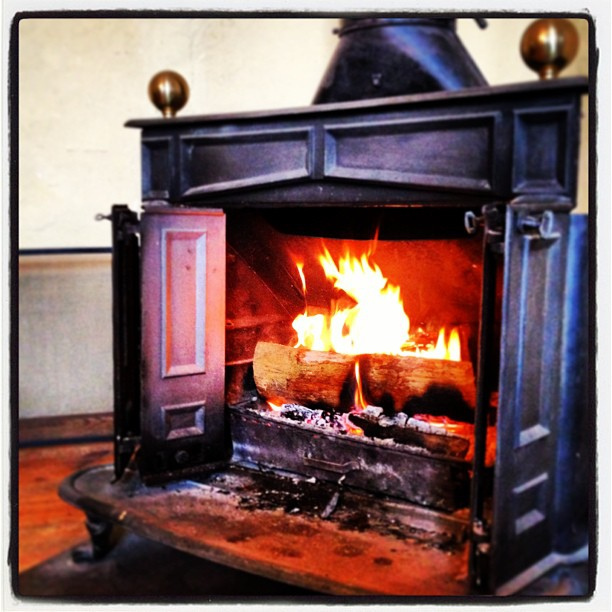The Franklin stove stands as a hallmark of ingenuity, showcasing how Benjamin Franklin transformed the traditional fireplace into a more efficient heating solution in the 18th century. Known for his numerous inventions, Franklin’s stove not only provided warmth during the brutal winters of the Little Ice Age but also revolutionized the way we understand domestic heating and air circulation. Joyce Chaplin’s exploration of the Franklin stove illuminates its role in the history of climate adaptation, emphasizing how Franklin’s innovation cleverly utilized atmospheric science principles to enhance comfort in homes. This remarkable creation contributed to new thinking about technology’s impact on our environment, directly linking to Franklin’s other inventive pursuits and scientific observations. As we delve into the history of the Franklin stove, we discover that it is much more than a mere heating device; it is a testament to the power of human creativity in addressing climate challenges.
Benjamin Franklin’s innovative fireplace, often referred to as the Pennsylvania fireplace, represents a significant stride in 18th-century heating technology. By reimagining the conventional hearth, Franklin sought to create a more effective means of warming living spaces during particularly harsh winters. This modification not only improved comfort but also allowed colonists to conserve wood and adapt to their environment, laying the groundwork for modern heating systems. It prompts us to reflect on how such historical inventions intersect with today’s discussions on climate adaptation and technology. Understanding this evolution sheds light on Franklin’s broader contributions to science and society.
The Historical Significance of the Franklin Stove
The Franklin stove, a remarkable invention by Benjamin Franklin, was conceptualized during an era that faced extreme climate conditions, particularly the bitterly cold winter of 1740-41. This novel design helped mitigate the requirement for firewood, making it a significant contribution to the technology of its time. In a historical context, the stove symbolized more than just warmth; it represented Franklin’s commitment to improving the living conditions of the colonial populace and his innovative spirit that reshaped how communities addressed environmental challenges. By understanding its historical significance, we can appreciate how this invention marked a pivotal shift in energy usage and domestic comfort, a precursor to modern climate adaptation strategies that echo Franklin’s foresight in atmospheric science.
Joyce Chaplin’s exploration of the Franklin stove in her work connects it to broader historical narratives of energy consumption and environmental awareness. The stove’s influence reached beyond mere heating, intertwining with pressing issues such as deforestation and fuel scarcity affecting early America. As settlers rapidly expanded their presence across the landscape, the stove emerged as a symbol of not only technological ingenuity but also a necessary response to the environmental constraints of the time. Drawing from Chaplin’s insights, we can investigate how Franklin’s adaptation to climate challenges provides valuable lessons for contemporary efforts aimed at sustainability and efficient resource management, thereby reinforcing the historical relevance of this pivotal invention.
Atmospheric Science and the Franklin Stove
The Franklin stove served as an important early experiment in understanding atmospheric science, particularly in the realm of heat distribution and convection. Franklin’s approach, which delineated how warm air rises and circulates, parallels his interests in meteorological phenomena. His insights provided a practical application of atmospheric theory within homes, advancing the public’s understanding of air dynamics and climate conditions. Chaplin highlights this connection, showing how Franklin’s work in atmospheric science laid the groundwork for future studies and innovations, linking daily living conditions with larger environmental processes. This synthesis of scientific knowledge with practical design exemplifies the innovative spirit prevalent during the Enlightenment and the quest to harness nature for human benefit.
Moreover, Franklin utilized the principles of convection not just in his invention but as a lens to explain weather patterns and atmospheric behavior. This groundbreaking approach allowed him to correlate the mechanics of indoor heating with external weather systems, such as the Gulf Stream. By effectively communicating these ideas through accessible language and analogies, Franklin democratized scientific knowledge, making it relatable to the general populace. Such dissemination of information was crucial in fostering a public understanding of environmental issues, and Chaplin underscores how this historical intersection of science and invention can inform our modern dialogue on climate adaptation and innovation in technology.
Impact of the Franklin Stove on Climate Adaptation
The invention of the Franklin stove came at a time when climate adaptation was not merely a concept but a necessity for survival in harsh winters. Franklin’s design was an ingenious solution to the heating problems faced by colonists, efficiently consuming less wood while maximizing warmth—a critical adaptation in an era marked by tree scarcity due to increased settlement. Chaplin emphasizes that Franklin recognized the need for sustainable practices even then, marking his attempts to minimize wood usage as an early reflection of climate-conscious thinking. The Franklin stove thus represents a blueprint for early American ingenuity in response to environmental challenges, highlighting the interconnectedness of technology and climate adaptation.
In contemporary discussions on climate adaptation, the lessons learned from Franklin’s approach are salient. The need for innovative solutions that merge comfort with environmental responsibility is more pressing than ever. Much like Franklin, today’s inventors and scientists are challenged to create technologies that not only serve immediate needs but also align with sustainable practices. Chaplin’s examination of the Franklin stove can inspire modern approaches to energy efficiency and climate resilience, reminding us that even in times of adversity, innovation—rooted in a deep understanding of our environmental context—can lead to transformative change.
The Legacy of Benjamin Franklin’s Innovations
Benjamin Franklin’s contributions to science, particularly his inventions, have left an indelible mark on American history and technological progress. The Franklin stove stands as a testament to his inventive genius and adaptability, highlighting his profound understanding of the interplay between technology and the environment. Franklin’s ability to harness scientific principles for practical applications showcases his forward-thinking approach that resonates in today’s innovation landscape. As historians like Joyce Chaplin document these achievements, they provide a broader understanding of how Franklin’s legacy influences contemporary thought around climate adaptation and technological advancement.
Moreover, the significance of Franklin’s inventions extends beyond their immediate utility; they reflect a mindset that embraces innovation in pursuit of improving human conditions. Chaplin argues that by exploring Franklin’s less-celebrated inventions, like the stove, we can gain insights into the evolving relationship between humans and their environment. This legacy invites current and future generations to cultivate a similar spirit of inquiry and reserve in addressing today’s pressing challenges, such as climate change and resource depletion. By diving into Franklin’s life and legacy, we unravel not just a historical narrative but also a blueprint for future innovations aimed at creating a more sustainable world.
Lessons in Climate Awareness from the Franklin Stove
The historical context surrounding the Franklin stove highlights critical lessons in climate awareness that resonate strongly today. As Franklin navigated the environmental difficulties of his time, his design was not merely about warmth but served as an incipient response to the pressing need for energy efficiency. This thrust towards efficiency anticipates modern debates surrounding climate change and the urgent need for sustainable practices in our everyday lives. Chaplin’s exploration into Franklin’s thought process reveals how early awareness of climate issues can inform contemporary strategies aimed at reducing carbon footprints and promoting ecological stewardship.
Moreover, the Franklin stove encapsulates a broader philosophy of innovation in the face of environmental challenges. It serves as an example of how scientific inquiry can lead to practical solutions that enhance quality of life while mitigating negative impacts on the environment. Today’s innovators can glean from Franklin’s methodologies, particularly his commitment to lessening fuel usage and addressing smoke emissions, as foundational principles for developing modern technologies that prioritize sustainability over convenience. Ultimately, the interaction between Franklin’s inventions and environmental consciousness provides invaluable insights for fostering a culture of responsibility and innovation as we confront today’s climate challenges.
Franklin’s Innovative Spirit and Modern Implications
Franklin’s innovative spirit exemplified a dedication to inquiry and improvement that remains relevant today. His experimentation with the Franklin stove embodies a commitment to creating practical solutions through rigorous scientific principles, a characteristic that defined the Enlightenment era. In a modern context, this inventive drive acts as a compelling reminder of the importance of creativity and resourcefulness in addressing current global challenges. Chaplin suggests that Franklin’s approach teaches us to embrace complexity while prioritizing practicality, inspiring today’s inventors to seek sustainable alternatives to the issues we face.
The implications of Franklin’s spirit of innovation extend far beyond his era. By emphasizing the need for multi-faceted solutions to climate change, he invites contemporary society to look beyond singular fixes and instead foster a collaborative environment for problem-solving. In today’s climate discourse, the intersection of technology and environmental awareness reflects Franklin’s early insights into effective adaptation strategies. Thus, his legacy continues to inspire ingenuity while challenging us to approach modern solutions for climate resilience with the same fervor and creativity that characterized his own experience.
Benjamin Franklin: A Pioneer of Energy Efficiency
As a pioneer of energy efficiency, Benjamin Franklin’s inventions were rooted in the principle of maximizing output while minimizing inputs—a concept increasingly vital in contemporary technology. The Franklin stove emerged from Franklin’s desire to heat homes effectively while consuming less wood, serving not just as a functional appliance but as a model of resourcefulness reflecting an early understanding of energy sustainability. Chaplin underscores the relevance of Franklin’s intentions in today’s discussions surrounding energy consumption and environmental protection, illustrating how his practices laid the foundation for future advancements in energy-efficient technology.
Moreover, Franklin’s efforts to re-burn smoke from stoves not only depicted his concern for air quality but also set precedents for modern emissions-reduction strategies. His insights into efficiency continue to resonate today, encouraging innovation that remains mindful of environmental impacts. By studying Franklin’s life and work, contemporary society can draw inspiration from his pioneering approach, blending technological advancement with ecological consideration. In this way, Franklin’s legacy becomes a guiding force in the pursuit of energy-efficient solutions that meet the demands of modern life while cultivating a more sustainable future.
Franklin’s Inventions and Their Relevance Today
The relevance of Franklin’s inventions, notably the Franklin stove, extends into today’s conversations around climate change and technological innovation. His work elucidates the pressing connection between technology and environmental sustainability—a relationship that modern inventors can learn from as they tackle the challenges posed by climate change. Chaplin’s examination of Franklin’s methodologies reveals an enduring commitment to improving life conditions without sacrificing environmental integrity, a topic that is increasingly pertinent in light of contemporary climate discussions. The principles embodied in Franklin’s inventions, particularly in energy efficiency and adaptation, provide a vital framework for approaching the technological challenges of our time.
Furthermore, the legacy of Franklin’s inventions invites ongoing reflection on the ethical implications of innovation. As society grapples with the dual crises of climate change and resource scarcity, Franklin’s example challenges current thinkers and innovators to develop solutions that are not only functional and efficient but also considerate of their ecological footprints. The legacy of the Franklin stove serves not merely as a relic of the past but as a clarion call for modern makers to fuse ingenuity with responsibility. In embracing Franklin’s innovative spirit, we can seek solutions that address today’s pressing issues while anchoring ourselves in a tradition of thoughtful, sustainable invention.
Frequently Asked Questions
What is the history of the Franklin stove and its impact on climate adaptation?
The Franklin stove was invented by Benjamin Franklin in the early 18th century during the cold winter of 1740-1741. Designed to improve heating efficiency, it allowed colonists to use less wood for greater warmth, representing a climate adaptation strategy amidst the threat of deforestation. Franklin’s design evolved over the years, showcasing his scientific ingenuity and addressing the pressing heating needs of his time.
How did Benjamin Franklin’s inventions, particularly the Franklin stove, influence atmospheric science?
The Franklin stove played a significant role in advancing atmospheric science. Franklin utilized convection principles to explain how his stove effectively warmed a room. He linked these principles to natural atmospheric phenomena, such as storm systems and the Gulf Stream, making complex scientific concepts accessible to the public and inspiring future studies in meteorology.
In what ways did Joyce Chaplin’s book highlight the environmental implications of the Franklin stove?
Joyce Chaplin’s book, “The Franklin Stove: An Unintended American Revolution,” emphasizes the stove’s environmental implications by showcasing Franklin’s efforts to minimize smoke emissions and improve air quality. This focus on reducing pollution was ahead of its time and reflects Franklin’s awareness of environmental health, making his invention relevant to contemporary discussions on climate and air quality.
What were the primary motivations behind Benjamin Franklin’s design of the Franklin stove?
Benjamin Franklin was motivated to design the Franklin stove for multiple reasons: to provide efficient heating during harsh winters while also addressing the issue of deforestation and expensive firewood for the poor. His innovative approach aimed to create a more comfortable living environment and showcased Enlightenment beliefs in using science and technology for societal betterment.
How does the Franklin stove illustrate Benjamin Franklin’s role in early American innovation?
The Franklin stove exemplifies Benjamin Franklin’s role as an early American innovator by merging practicality with scientific principles. His ability to create an effective heating solution while addressing environmental concerns reflects his impact on technology and science, laying a foundation for future innovations in energy efficiency and atmospheric studies.
| Key Points |
|---|
| Benjamin Franklin invented the Franklin stove during the cold winter of 1740-1741, improving heating efficiency using less wood. |
| Franklin’s stove design sparked advancements in understanding atmospheric phenomena, contributing to his mapping of the Gulf Stream. |
| The stove was a part of climate adaptation efforts, responding to environmental challenges of the time. |
| Franklin’s efforts to minimize smoke emissions reflected early concerns about air quality and health. |
| Joyce Chaplin’s book ‘The Franklin Stove: An Unintended American Revolution’ explores these themes and their relevance today. |
Summary
The Franklin stove is not just an invention but a pivotal moment in understanding how technology can influence climate adaptation. Benjamin Franklin’s creation aimed to solve heating issues during severe winters while also addressing air quality, showcasing a forward-thinking approach to environmental challenges. Joyce Chaplin’s recent exploration into this invention illustrates its unexpected influence on scientific thought and its contemporary relevance, making the Franklin stove an essential topic for anyone interested in the intersection of history, science, and innovation.



